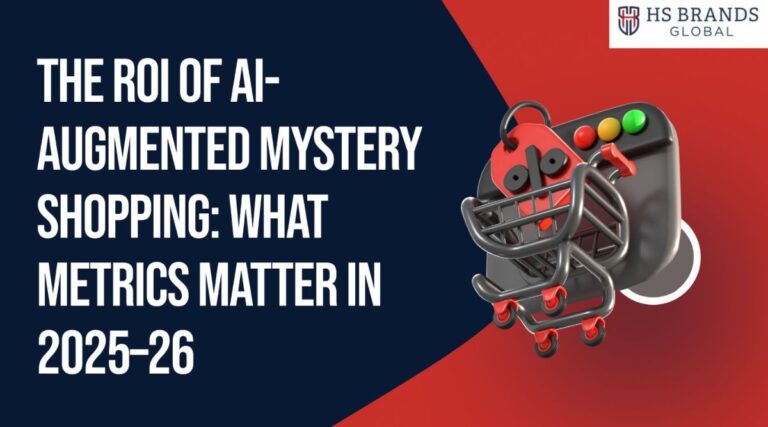An audit is a crucial component of retail business management, as it ensures that operations are running smoothly. It is the process of confirming the accuracy of the data or information pertaining to a company’s retail operations. Typically, retail audits include a systematic review and analysis of sales, inventory, and other relevant activities.
The HSBrands 0ne of the best retail audit companies provides businesses with a variety of benefits, including the identification of inconsistencies in their processes and operations, the evaluation of their performance, and the verification of their compliance with applicable laws and regulations. In addition, it assists them in identifying areas for improvement, allowing them to become more efficient and cost-effective.

For instance, a retail audit can assist a store in identifying areas where they are losing money due to inefficient operations, such as overstocking or understocking inventory or failing to meet customer expectations. It can also assist them in identifying areas where operations can be optimized, such as by streamlining their supply chain or implementing new technology.
In addition, the retail audit conducted by HS Brands can assist businesses in gaining a deeper understanding of their customers. By collecting information about customers’ shopping habits, preferences, and buying patterns, businesses can better tailor their products and services to meet their needs. This can help them increase customer satisfaction and loyalty, as well as their profit margin.
Overall, retail audits are a crucial aspect of business management that can assist organizations in ensuring their operations are operating as efficiently and effectively as possible. It can provide them with valuable insights into their customers, operations, and performance, enabling them to make the necessary improvements and adjustments to maintain market competitiveness.
Types of Retail Audits
Compliance Audit
The compliance audit is an important retail store safety inspection that determines whether the store is operating in accordance with government and industry regulations and guidelines. The store audit ensures that the store adheres to all applicable laws and regulations to safeguard its customers and employees. Depending on the industry, a
compliance audit can cover a range of topics, including workplace safety, environmental protection, and health and safety.
The compliance audit conducted by HS Brands ensures that the retail store adheres to the industry’s rules and regulations. It also contributes to the store’s ability to provide a safe and secure environment for its customers and employees. Businesses must also conduct a compliance audit to ensure that they are adhering to government and industry regulations and standards.
Compliance audits are essential to store audit programs. The HS Brands audit assists in evaluating the store’s compliance with government and industry-mandated regulations and guidelines. To protect customers and employees, the audit also checks the store’s compliance with laws and regulations. The audit also finds noncompliance and ensures the store follows all laws and regulations.
Any store audit program must include a compliance audit to ensure compliance with all regulations. The audit ensures customer and employee safety in the store. The store must also pass a compliance audit.
Mystery Shopping Audit
Mystery shopping audits are an important tool for retail store owners and managers. This audit entails a mystery shopper’s visit to the store in order to evaluate the customer experience and identify areas for improvement. A mystery shopper is typically a customer who visits the store and observes customer service, store layout, product availability, and other aspects of the shopping experience. The mystery shopper then reports his or her findings to the store’s management, who can use the data to make changes and improvements.
To ensure the accuracy and quality of the audit, it’s important to have a comprehensive retail store safety inspection checklist. This checklist should include items such as evaluating the store’s security measures, ensuring the store is well-lit and clean, inspecting for any potentially dangerous materials, and confirming that customer service is satisfactory. Examining the store’s layout is also crucial for making sure clients can quickly locate products of interest. Lastly, the mystery shopper should confirm that the store has adequate stock and that all items are correctly priced and labeled.
HS Brands Mystery shopping audits are a great way for retail store owners and managers to identify areas for improvement. Using the results of an audit conducted by
HS Brands, store owners, and managers can make adjustments that may increase customer satisfaction and boost sales. Store owners and managers can ensure that their store meets customer expectations by using a retail store safety inspection checklist and a mystery shopper.
Loss Prevention Audit
The HS Brands loss prevention audit is an in-depth analysis of a retail store’s inventory, customer, and employee activity to detect and prevent losses due to theft, fraud, or other criminal activities. This audit is essential for any retail store in order to identify potential risks and implement loss-prevention measures.
A thorough retail store safety inspection checklist is required to ensure that certain processes are in place, including customer and employee access control, alarm systems, and surveillance cameras. Additionally, the store should have procedures in place to detect any suspicious behavior or activities, such as unauthorized access, and to prevent potential losses.
Maintaining and checking the store’s inventory system is crucial. Checking inventory periodically prevents overstocking and shelf discrepancies. Customer and employee records can be audited regularly to verify transactions and employment authorization.
The store should also investigate and correct suspicious activity and losses. An internal investigation, notifying authorities, or disciplinary action may be needed. Store managers benefit from loss prevention audits. Store owners must take precautions to prevent theft and crime.
Performance Audit
Retail stores rely heavily on performance audits to evaluate their performance and identify areas for improvement. It assesses the store’s operations and employee performance. The audit usually examines customer service, inventory management, operations, and store management. Customer service, product knowledge, and employee performance are also evaluated in the audit.
A retail store visit checklist is the initial step of the HS Brands performance audit. This checklist provides a complete store and staff overview. Customer service ratings, feedback, store policies, and employee performance are covered. The audit assesses
the store’s finances and operations. Sales, profits, inventory, customer service surveys, feedback, and satisfaction ratings are also on the list.
Performance audits are essential for retail businesses looking to improve. The store can identify issues and improve performance with it. HS Brands’ performance audit sheds light on store operations and employee performance. It shows the store what’s working and what’s not. Performance audits can guide store operations and employee decisions.
Importance of Retail Audits
Improving Operations
A retail store audit is a valuable tool for improving operations and reducing costs. Retail store audit software helps companies assess store performance. Companies can improve operations, efficiency, and costs with retail store audit software.
HS Brands retail store audits help companies determine the effectiveness of their store operations. Companies can identify inventory shrinkage, staffing issues, and customer service issues with audits. Understanding these issues lets companies improve operations and cut costs.
Retail store audit software can also evaluate retail store employees. This software can analyze employee performance and identify areas for improvement. This lowers staff turnover and improves customer understanding.
Store audits help companies identify areas for improvement. Store audits identify cost-saving opportunities like inventory reduction and customer service improvement. This helps firms find ways to cut costs and boost efficiency.
Maintaining Compliance
Conducting an HS Brands compliance audit is a vital step for any business that wants to avoid legal trouble and fines by staying in compliance with all applicable laws and regulations. Retail store safety inspection checklists can aid compliance audits. To avoid legal issues and fines, retail stores should complete a safety inspection checklist.
The compliance audit checks the company’s policies and procedures against all laws and regulations. Financial audits ensure proper management. Auditing the company’s risk management practices reduces risks.
HS Brands Compliance audits reduce the risk of costly legal issues or fines by ensuring regulatory compliance. These audits can identify areas for improvement. HS Brands Compliance audits reduce legal risk and ensure compliance.
Enhancing the Customer Experience
HS Brands’ mystery shopping audits reveal customer perceptions to improve customer experience. Mystery shoppers evaluate customer service in retail stores and restaurants. They pose as customers to audit customer service. Mystery shoppers assist companies in improving customer service.
A mystery shopper may ask, “Was the staff friendly and helpful?” or “Did the store has a good selection of merchandise?” These questions can help companies assess their customer service and make improvements. Mystery shoppers also assess the store’s cleanliness and appeal.
Focusing on customer feedback improves the customer experience. Customer feedback should be used to improve customer service. Customers can rate their satisfaction and answer customer service audit questions. This feedback helps companies improve customer experiences.
Reducing Losses
Loss prevention audits are essential to business success. HS Brands audits can reduce theft, fraud, and other losses for companies. A merchandising audit checklist and store audit list help companies identify risk areas and review their controls to protect their assets.
The first step in a loss prevention audit is to review the company’s internal control procedures. This includes reviewing the company’s asset and employee protection policies. Locks, cameras, employee background checks, and access control are examples of this. Inventory, cash, and other potential fraud or theft areas should be monitored.
After assessing internal controls, review the company’s merchandising audit checklist and store audit list. These documents describe the company’s assets and security measures. Auditors should examine the company’s inventory, cash flow, and asset protection processes. They should also check for discrepancies between the company’s records and inventory levels.
Risk management should be assessed after reviewing internal control procedures, merchandising audit checklists, and store audit lists. This includes reviewing their loss reporting, investigation, and theft and fraud response procedures. To ensure employees understand loss prevention policies, auditors should check company training.
The Retail Audit Process
Planning – Planning is the foremost step in the retail audit process and plays an important role in the success of the audit. It helps determine the audit’s scope and objectives, ensuring that all store areas are properly assessed. This includes understanding the merchandising audit checklist and creating a comprehensive retail store audit program. Make sure your retail audit meets your goals by planning ahead.
Data Collection- Data should be used to create a merchandising audit checklist, a retail audit process, a retail store audit program, and a store audit procedure. These tools and protocols can help analyze and assess all data to identify and target areas for improvement. Then, the right protocol can be implemented to maximize retail store and employee efficiency. These audit tools and data can help organizations improve operations.
Analysis- In the merchandising audit checklist, retail audit, and store audit, data analysis is essential. Organizations can optimize their retail store audit program by identifying trends, issues, and areas for improvement. This analysis can also reveal ways to boost sales.
Reporting- To ensure business compliance with industry regulations, the merchandising audit checklist, retail audit process, retail store audit program, and store audit procedure must be reported. To maintain operational excellence, a report with findings and recommendations is created. This will also guide resource allocation decisions for maximum efficiency and profit. To improve based on new findings, the report should be updated regularly.
Implementation- To improve store operations and customer satisfaction, the merchandising audit checklist, retail audit process, retail store audit program, and store audit procedure are used. These changes can help the store streamline operations. Retailers should also conduct regular store audits to identify potential issues. By doing so, they’ll maintain high service levels and customer satisfaction.
Benefits of Retail Store Inspections with HS Brands Audit
The HS Brands retail audit offers numerous benefits to businesses, including the identification of inconsistencies in their processes and operations, the evaluation of their performance, and the confirmation of their compliance with applicable laws and regulations. Additionally, it helps them identify areas for improvement, enabling them to become more efficient and cost-effective.
Businesses can better understand their customers with HS Brands’ retail audit. By gathering data on customers’ shopping habits, preferences, and purchasing patterns, businesses can better tailor their products and services to meet their needs. This can help them boost customer satisfaction, brand loyalty, and profit margins.
Retail audits are an important part of business management that can help companies optimize their operations. It can provide valuable insights into their customers, operations, and performance, enabling them to make the necessary improvements and adjustments to stay competitive.








